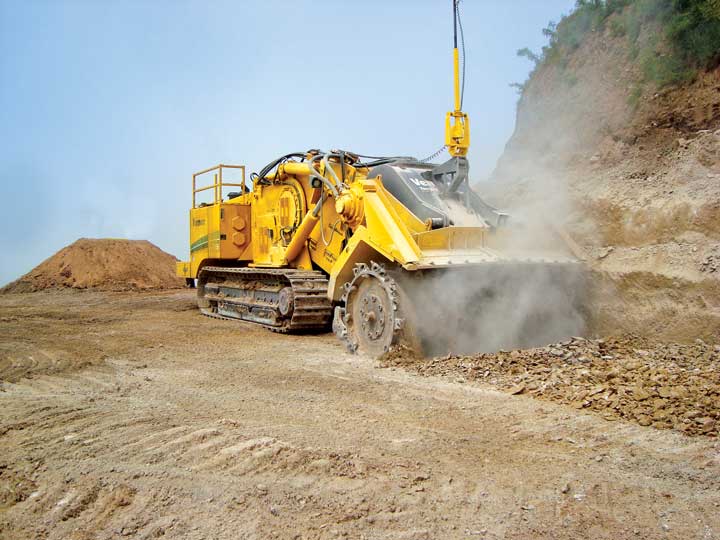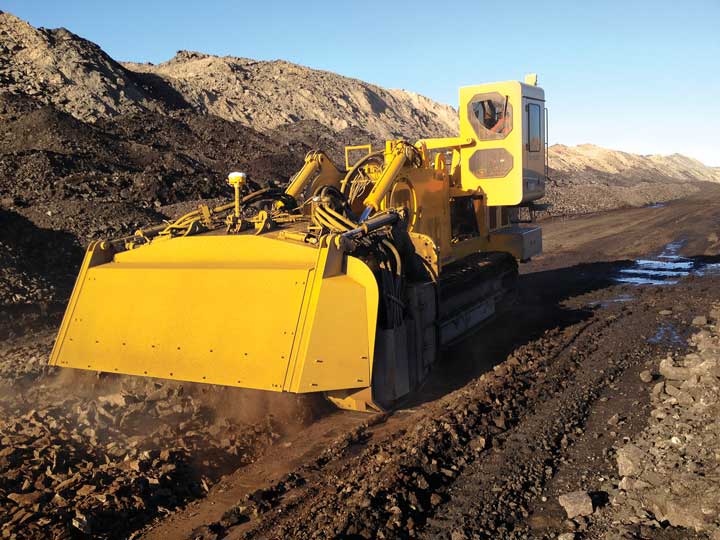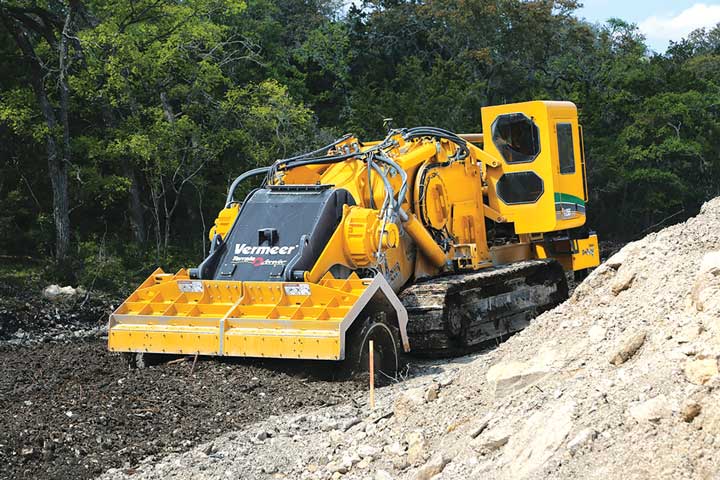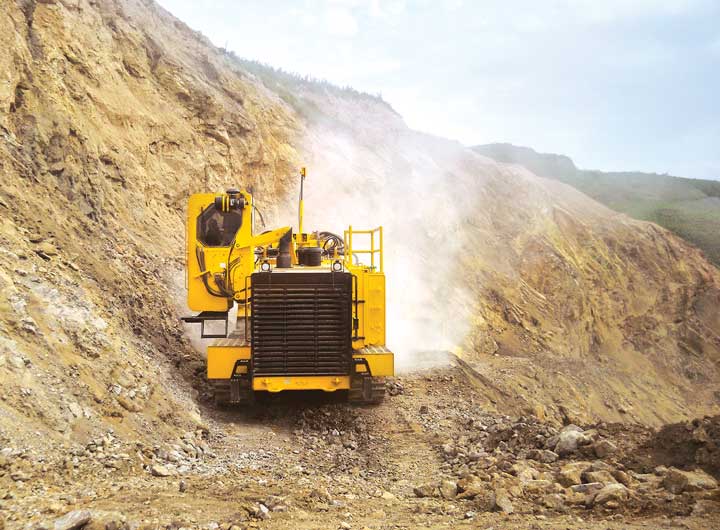
Australia-based Proof Engineers is pioneering an innovative approach to haul road construction and maintenance using a Vermeer Terrain Leveler surface excavation machine.
Consultant finds surface miner improves quality of road, is faster than traditional method
There’s a saying in the mining industry James Miedecke is fond of: Good roads, more loads.
It’s hard to overstate the importance of a haul road to a mining operation. Research has found that truck haulage costs can account for up to 50% of surface mining expenses.
Yet Miedecke, who is roads and drainage specialist for mine road consultant Proof Engineers, said many mining companies don’t put enough resources and forward-thinking into haul road construction and maintenance.
“Often they’ll go down a track that might be a short-term gain, but it gives them a little long-term pain,” he said.
He started seeing a change in attitude around the time commodity prices started to decline. Yes, budgets were getting squeezed, but finding efficiencies also became critical. Haul roads can help improve a mine’s overall productivity—or, conversely, they can be costly.
“A rule of thumb is that a poorly constructed road costs 10 times that of a well-constructed road just in maintenance costs alone,” Miedecke said.
Australia-based Proof Engineers is helping to pioneer an innovative approach to haul road construction and maintenance by using a Terrain Leveler surface excavation machine (SEM) from Vermeer, a U.S.-based surface mining equipment manufacturer. Proof Engineers has found the machine produces a better overall surface quality, creates a road that allows for faster equipment speeds, reduces the number of resources required in road construction and maintenance, and enables a significantly faster process.
All of that can lead to a more cost-effective approach.
“I would expect a savings of at least 30% by using the surface excavation machine compared with the conventional method,” Miedecke said.
Proof Engineers has used the Vermeer T1255III Terrain Leveler SEM, which can cut an area up to 68.6 cm (27 in.) deep and 3.7 m (12.1 ft) wide in a single pass. Miedecke says it can mill and crush in situ material to produce a more consistent and ideal particle size, as well as offer improved grading.
 Once a road is complete, maintenance is a major ongoing issue. Dealing with water—drainage—is the top priority.
Once a road is complete, maintenance is a major ongoing issue. Dealing with water—drainage—is the top priority.HAUL ROAD PROBLEMS
Miners, Miedecke said, are earth movers, not road builders, so they call in companies like his to help with haul road construction and maintenance. Proof Engineers works globally as a consultant on the construction, maintenance and condition measurement of haul roads.
When evaluating an existing road, Miedecke often finds it in poor shape. The surface and substructure are degrading, drainage is a problem, and the size and quality of the road material is unsuitable. Many of these issues begin with the design and initial construction of the road.
In haul road construction, the traditional method is to import material to the road site. Due to the scale of mining operations, the size of the material is often larger than is desirable. Miedecke often sees oversized material in the critical 2-m-deep (6.5 ft) layer below the surface, which will lead to inconsistent compaction and settlement that in turn results in high maintenance and grading costs after construction.
“You’ve got very poor particle size distribution, which leads to voids among all those rocks,” he said. “The mining company will continue building the road over that area, but as time goes on, there will be settlement and differential compaction, and then the road becomes undulated and difficult to ride, difficult to grade. It can lose drainage integrity. You’ll have ponds in low areas of the road.
“It becomes a compounding problem.”
A fleet of equipment is necessary in this traditional approach, including shovels or wheel loaders and haul trucks to move material to the road construction site, one or two large bulldozers, one or two large graders, a water cart, and a compactor.
There are a lot of steps in this approach. In fact, Proof Engineers has an 11-action process just for the production of surface material.
Once a road is complete, maintenance is a major ongoing issue. Dealing with water—drainage—is the top priority.
“Water will destroy your substructure of the road if it’s in the wrong places,” Miedecke said.
Another maintenance item in both hard rock and coal environments is spillage from trucks. A lot of fine material falls out of trucks and gets run over. When it gets wet, it can become slippery. And then the mine loses time due to wet weather.
Also a factor is the growing size of haul trucks and their payloads. There are now ultra-class trucks with gross weights of 650 metric tons (716.5 tons), or more. The pitch and yaw characteristics of the large trucks put more stress on the road as a whole and deeper into the substructure. Miedecke has seen trucks essentially dig up material from 3 or 4 m (9.8 or 13.1 ft) below the surface of seemingly well-constructed haul roads. He recalls an instance a couple of years ago when a haul road in Australia that had been preforming well developed problems after the mine began using larger trucks.
“The subgrade wouldn’t stand up to the big trucks and would even shift,” he said. “The road became almost impassable.”
 Because it produces an acceptable final particle size on its own, a surface excavation machine eliminates several steps normally needed to produce adequate road construction material, including drill and blast, crushing and stockpiling, and the hauling of in situ material for processing.
Because it produces an acceptable final particle size on its own, a surface excavation machine eliminates several steps normally needed to produce adequate road construction material, including drill and blast, crushing and stockpiling, and the hauling of in situ material for processing.ALTERNATIVE APPROACH
The Vermeer Terrain Leveler SEM provides solutions to most of these issues. Miedecke became aware of the machine while looking for an answer to a common problem: how to deal with oversized material near the surface of a road that needs rehabilitating.
Typically, dozers are used to extract the large rocks. Miedecke thought if that material could be broken up and incorporated into the surface materials, the road would be structurally stronger. There are additional benefits when the particle size distribution is improved in that the dusty fine particles are held longer and the road will require less water to maintain dust levels. The Terrain Leveler SEM offered that capability.
The machine has a cutting drum that operates with a top-down motion, which allows the cutter teeth to penetrate without using the machine’s tractive effort to drive the teeth into the rock. As the unit travels backward and the drum rotates, the teeth on top of the drum advance over the top of the unbroken material surface. The technique promotes greater operational efficiency as more horsepower goes into cutting rock and less into moving the machine.

BETTER OUTCOME
One project in particular proved to Proof Engineers the value of the surface excavation machine. In 2013, Proof Engineers was part of a rehab project at a South African coal mine where more than 60% of the haul roads were on coal benches.
Poor blasting controls and uneven topography made those roads difficult to construct and maintain. They had very slow haul velocities and were rough and dirty.
Proof Engineers tried two ways to make the road better. One used two bulldozers with rippers to break the coal, and then the machines track rolled the coal to crush the larger pieces. After that a grader shaped the road. Finally, haul trucks compacted the material. They improved the quality of the road, but it was very resource- and time-consuming.
The other method involved a Vermeer T1255III Terrain Leveler SEM, which could mill the coal in situ. It exceeded the productivity of the two large bulldozers by a considerable degree, and the particle size distribution was better and had less oversized particles.
“It was a faster process, which ended up with a better outcome for the client,” Miedecke said.
Truck travel speeds were about 50% higher than both the traditional construction method and the one using bulldozers. In this instance, it also took less than half the time to grade and shape the road with the SEM than it did with the bulldozers.
Miedecke said the Terrain Leveler SEM also produces a suitable particle size distribution in one pass, whether it’s cutting large boulders or coal. The bulldozer operation, by comparison, took four passes and then still had to track roll the coal.
OTHER BENEFITS
Miedecke has identified several other benefits in using the Terrain Leveler SEM.
One is a reduction in the traditional 11-action process of producing road surface material. The surface excavation machine eliminates several of those steps, including drill and blast, crushing and stockpiling, and the hauling of in situ material for processing.
The machine also helps with the issue of material falling from haul trucks, which affects maintenance of roads.
“By milling the surface with the Terrain Leveler SEM—and it might only be for 300 millimeters deep—you’ll be mixing up the material, maybe introducing some fresh coarse material,” Miedecke said. “It mills it through, and then you’ve got a good particle size distribution in the surface material again and you’ve negated the issue of those fines.”
The Terrain Leveler SEM also is versatile. Proof Engineers uses it for haul road construction and maintenance, but it also can mine ore. Miedecke noted it’s been shown to be proficient at surface mining thin seams that drill-and-blast methods often cannot.
“I could see if you had a Terrain Leveler SEM on-site, when it’s not doing work associated with haul roads, there’s plenty of opportunities for it to be mining those particularly difficult areas, especially in coal mining,” he said.









